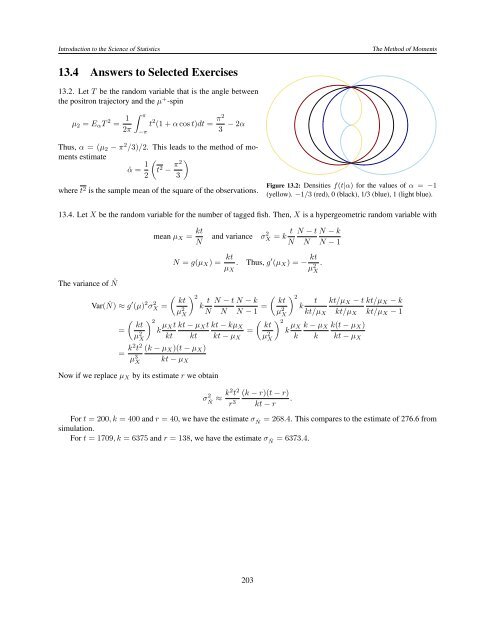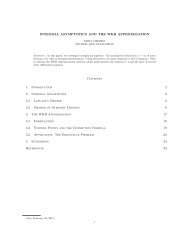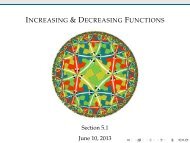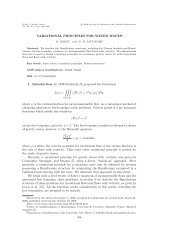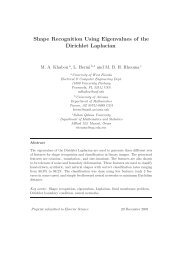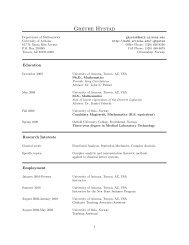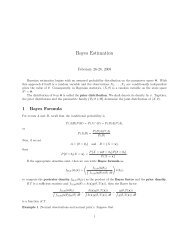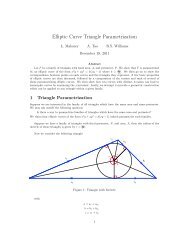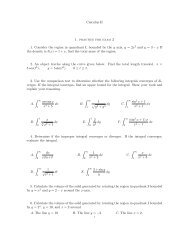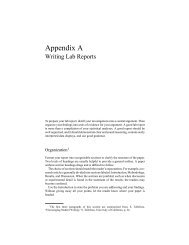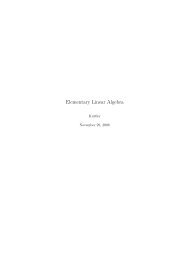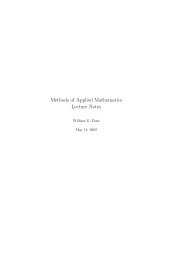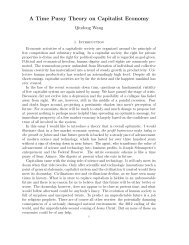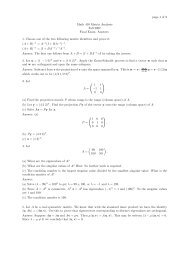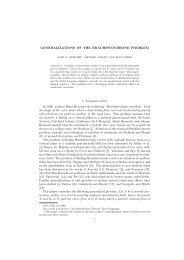Method of Moments
Method of Moments
Method of Moments
Create successful ePaper yourself
Turn your PDF publications into a flip-book with our unique Google optimized e-Paper software.
Introduction to the Science <strong>of</strong> Statistics<br />
13.4 Answers to Selected Exercises<br />
13.2. Let T be the random variable that is the angle between<br />
the positron trajectory and the µ + -spin<br />
µ 2 = E ↵ T 2 = 1 Z ⇡<br />
t 2 (1 + ↵ cos t)dt = ⇡2<br />
2⇡ ⇡<br />
3<br />
⇡ 2 /3)/2. This leads to the method <strong>of</strong> mo-<br />
ˆ↵ = 1 ✓t<br />
2<br />
2 ⇡ 2 ◆<br />
3<br />
Thus, ↵ =(µ 2<br />
ments estimate<br />
2↵<br />
where t 2 is the sample mean <strong>of</strong> the square <strong>of</strong> the observations.<br />
y<br />
-0.3 -0.2 -0.1 0.0 0.1 0.2 0.3<br />
The <strong>Method</strong> <strong>of</strong> <strong>Moments</strong><br />
Figure 13.2: Densities f(t|↵) for the values <strong>of</strong> ↵ = 1<br />
(yellow). 1/3 (red), 0 (black), 1/3 (blue), 1 (light blue).<br />
-0.3 -0.2 -0.1 0.0 0.1 0.2 0.3<br />
13.4. Let X be the random variable for the number <strong>of</strong> tagged fish. Then, X is a hypergeometric random variable with<br />
mean µ X = kt<br />
N and variance 2<br />
X = k t N t N k<br />
N N N 1<br />
N = g(µ X )= kt . Thus, g 0 (µ X )= kt<br />
µ X µ 2 .<br />
X<br />
The variance <strong>of</strong> ˆN<br />
✓ ◆ 2<br />
Var( ˆN) kt<br />
⇡ g 0 (µ) 2 X 2 =<br />
µ 2 k t ✓ ◆ 2<br />
N t N k kt<br />
X<br />
N N N 1 = t kt/µ X t kt/µ X k<br />
µ 2 k<br />
X<br />
kt/µ X kt/µ X kt/µ X 1<br />
✓ ◆ 2 kt<br />
= k µ ✓ ◆ 2<br />
Xt kt µ X t kt kµ X kt<br />
= k µ X k µ X k(t µ X )<br />
kt kt kt µ X k k kt µ X<br />
µ 2 X<br />
= k2 t 2<br />
µ 3 X<br />
(k µ X )(t µ X )<br />
kt µ X<br />
Now if we replace µ X by its estimate r we obtain<br />
2ˆN ⇡ k2 t 2<br />
µ 2 X<br />
(k r)(t r)<br />
r 3 kt r<br />
For t = 200,k = 400 and r = 40, we have the estimate ˆN<br />
= 268.4. This compares to the estimate <strong>of</strong> 276.6 from<br />
simulation.<br />
For t = 1709,k = 6375 and r = 138, we have the estimate ˆN<br />
= 6373.4.<br />
.<br />
x<br />
203


